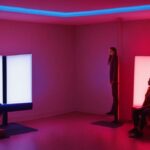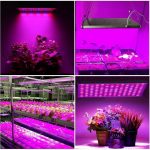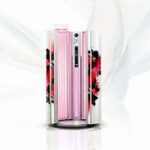Last Updated on 12 months by Francis
Contents
Understanding Seasonal Affective Disorder
Seasonal Affective Disorder (SAD) is a type of depression that affects people during the winter months when there is less sunlight. It is estimated that around 10 million Americans suffer from SAD, and it can severely impact their quality of life. Symptoms of SAD can include fatigue, low mood, irritability, and difficulty concentrating. While there are medications and therapies that can help alleviate these symptoms, light therapy has emerged as a popular and effective form of treatment.
How Does Light Therapy Work?
Light therapy involves using a special lamp that emits bright light, similar to natural sunlight. By exposing yourself to this light for a certain period each day, you can help regulate your body’s circadian rhythm and improve your mood. The light from the lamp is much brighter than regular indoor lighting and is specifically designed to mimic the effects of sunlight.
Different Types of Light Therapy
There are several different types of light therapy lamps available on the market, each with its own unique features and benefits. Some of the most popular types include:
1. Bright Light Therapy
Bright light therapy is the most common type of light therapy used to treat SAD. It involves using a lamp that emits 10,000 lux of light, which is about 20 times brighter than regular indoor lighting. The light is typically white or blue and is designed to mimic the effects of natural sunlight. Most people use bright light therapy for around 30 minutes each day, usually in the morning.
2. Dawn Simulation Therapy
Dawn simulation therapy involves using a lamp that gradually increases in brightness, simulating the sunrise. The idea is that by waking up to a gradually increasing light, your body’s circadian rhythm will be better regulated, and you’ll feel more energized and alert throughout the day. Dawn simulation therapy is often used in conjunction with bright light therapy.
3. Blue Light Therapy
Blue light therapy involves using a lamp that emits blue light, which is believed to be especially effective at regulating the body’s circadian rhythm. Some studies have shown that blue light therapy can be just as effective as bright light therapy in treating SAD. Blue light therapy lamps are usually smaller and more portable than bright light therapy lamps, making them a good option for people who need to use them on the go.
Choosing the Best Light Therapy Lamp
When choosing a light therapy lamp, there are several factors to consider. Some of the most important include:
1. Brightness
The brightness of the lamp is one of the most important factors to consider. Most experts recommend using a lamp that emits at least 10,000 lux of light. However, some people may find that a lamp with a lower brightness level is still effective for them.
2. Color of Light
The color of the light emitted by the lamp can also be an important factor. Most light therapy lamps emit white or blue light, but some may emit other colors. It’s important to choose a lamp with a color of light that you find comfortable and effective.
3. Size and Portability
The size and portability of the lamp may also be important, especially if you plan to use it at home and at work. Some lamps are designed to be compact and portable, making them easy to use on the go.
Other Considerations
While light therapy can be an effective treatment for SAD, it’s important to remember that it may not work for everyone. Some people may not respond well to light therapy, while others may experience side effects such as headaches, eyestrain, or nausea. It’s always a good idea to speak with your doctor before starting any new treatment for SAD.
Final Thoughts
If you suffer from SAD, light therapy can be an effective and non-invasive form of treatment. By choosing the right type of lamp and using it consistently, you can help regulate your body’s circadian rhythm and improve your mood. Whether you choose bright light therapy, dawn simulation therapy, or blue light therapy, there are many different types of lamps available on the market to choose from. With the right treatment plan in place, you can manage your SAD symptoms and enjoy a happier, healthier winter season.
Seasonal Affective Disorder (SAD) is a form of depression that affects individuals during the winter months when there is less exposure to sunlight. Light therapy is often used as a treatment for SAD, but with so many options available on the market, it can be challenging to determine which one is best. In this article, we will explore what the best light therapy is for SAD and what factors individuals should consider when choosing a therapy device.
FAQs – What is the best light therapy for SAD?
What is SAD?
Seasonal Affective Disorder, or SAD, is a form of depression which usually strikes in winter, when shorter daylight hours and lack of sunlight can affect hormone levels in the body. Symptoms of SAD may include irritability, fatigue, restlessness, difficulty concentrating, social withdrawal, and changes in appetite and sleep patterns.
What is light therapy?
Light therapy involves the use of a light box or other light source that shines very bright light, mimicking natural outdoor light. By exposing people with SAD to this light for a period of time each day, it can effectively alleviate symptoms of SAD by boosting mood and regulating hormone levels.
What type of light therapy is best for SAD?
The best type of light therapy for SAD depends on the individual and their personal preferences. The most important thing to look for is a light box that emits 10,000 lux, as this is the intensity of light required to be effective. Some people may prefer a smaller light box that can be easily placed on a desk or bedside table, while others may prefer a larger light box that can be positioned on the floor or wall.
How long should light therapy sessions last?
Most experts recommend starting with a session of 20-30 minutes each day, increasing to 45-60 minutes if necessary. It is also best to use the light therapy box in the morning, as this can help regulate your body’s natural circadian rhythms.
Are there any risks associated with light therapy?
Light therapy appears to be safe for most people, but there are some potential side effects to be aware of, including nausea, headaches, and eye strain. These side effects are typically mild and go away within a few days, but it is always best to consult with a healthcare professional before starting light therapy.
Can light therapy be used in conjunction with other treatments for SAD?
Yes, light therapy can be used alongside other treatments for SAD, such as medication and psychotherapy. In fact, combining light therapy with other treatments may provide even greater relief from symptoms of depression. It is important to discuss any treatment plan with a healthcare professional before starting to ensure that it is safe and effective.


.jpg)




